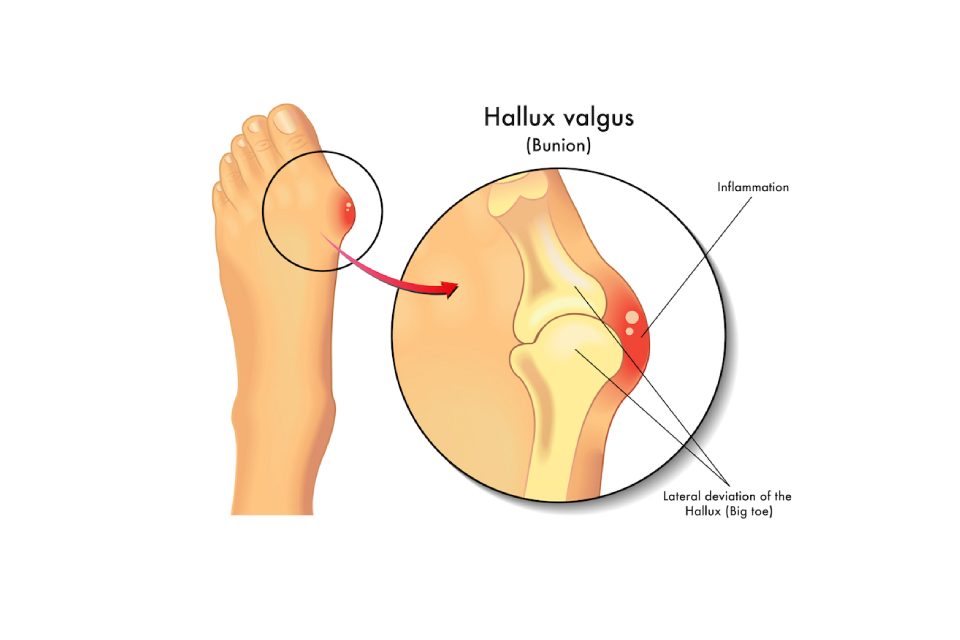- Have any questions?
- +91-9811443717
- info@dranujchawla.com
5 ways to ease bunion pain without surgery

Foot bunion- who gets it and why?
April 15, 2021
10 things you need to know about bunions
April 27, 20215 ways to ease bunion pain without surgery

Sometimes the wrong pair of footwear can lead to soreness in our feet. But in some patients, this becomes a part of their daily life where any narrow shoes or high heels trigger discomfort in the big toe and other toes. This problem in the big toe is called a bunion. If you are experiencing this problem with your toes, you need to take some extra steps to maintain the foot health. Let us know what can be the reason behind this foot problem and how to get relief from it.
Bunion- deteriorating foot health & structure
Toes play an important role in supporting and balancing our body weight. These are made up of multiple phalanges (proximal, middle, and distal), muscles, ligaments, and nerves. Except for the big toe (which has only 2 phalanges), all the other toes have three phalanges. Toes play an important role in maintaining the balance and support of the body during standing or walking and the movement in the toes helps in push-off during walking and running. Due to the bunion, a bump is developed on the base of the big toe. This medical condition (hallux valgus) can lead to inflammation near the bump, intense pain, and can limit the range of motion of the big toe.
In the initial stage, it can be treated through non-surgical methods. But if it is advanced or not treated effectively, it may progress to structural deformity as the big toe inclines towards the adjacent toe. Such a situation can only be treated through a surgical procedure.
With some medical help and care, one can alleviate bunion pain without surgery. Let’s discuss some in the upcoming section.
-
Maintain healthy BMI
The vital tip for treating foot problems is maintaining a healthy weight. Excess weight may become a challenge in treating any foot problem due to extra pressure on the feet. Moreover, due to the inability to walk, the active life of a person gets affected, which can further lead to weight gain.
-
Switch to pair of comfortable shoes
One of the prime reasons for developing a bunion is shoes with a narrow toe box. Tight footwear compels toes to crawl together and progress to misalignment. It affects your style of walking and the balance of the body. Such a scenario directly targets the metatarsophalangeal joint as the entire weight is directed in a wrong alignment and leads to the formation of a bunion. As soon as you observe a bunion or corn, switch to shoes that have enough space for your toes.
-
Ice therapy for alleviating pain
The easiest way to get relief from inflammation and pain is by icing the region. Apply ice for around 10 to 15 minutes on the affected area. It numbs the pain and also helps in reducing inflammation and redness. Repeat these steps at least 3-5 times a day.
-
Bunion pads and night splints
As the big toe inclines towards the second toes, the bump at the base of the big toe becomes more prominent and is the most common cause of pain during daily activities. Applying pads on the bunion may help to cushion the area and prevent the pain arising due to its friction with the shoes. Similarly, splints help in aligning the toes to the correct position and hence can be helpful in preventing the soreness that happens due to a deformed toe or rubbing of the big toe on the second toe. None of these measures though have been shown to correct the deformity.
-
Customized orthotics
Bunion deformity can be associated with flat foot and instability in the midfoot joint (tarsometatarsal joint). It can also lead to deformities and increased pressure under the lesser toes. Your feet need extra support in such a condition and hence custom orthotics can support in spreading the workload evenly throughout the feet so that no region of the foot gets affected with excess pressure. An insole in the form of arch support, heel wedge, or metatarsal pad and the type depends on the foot structure and requirement. Hence, you should consider a suggestion from a medical expert before choosing the orthotics.
-
Analgesia
In case of unremitting pain arising from a bunion, anti-inflammatory drugs called NSAIDs can be used either locally in the form of an ointment, cream, or patch or orally in case of severe pain.
These are some easy ways to alleviate bunion pain. But there are many foot exercises that can also be helpful in treating a bunion at home. We shall be discussing such exercises in our next blog. If you are looking for medical help in foot pain treatment, then you can consult Dr. Anuj Chawla. He is an experienced foot and ankle doctor in Gurgaon and has helped many patients is heeling foot problems.

